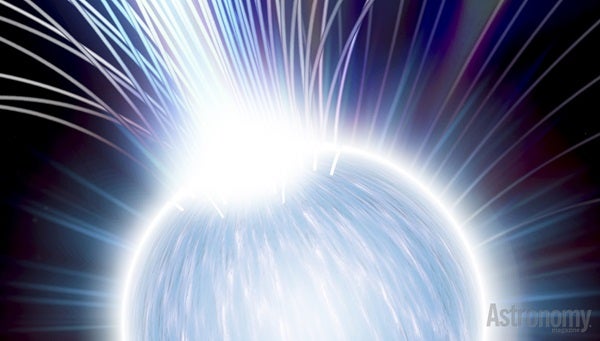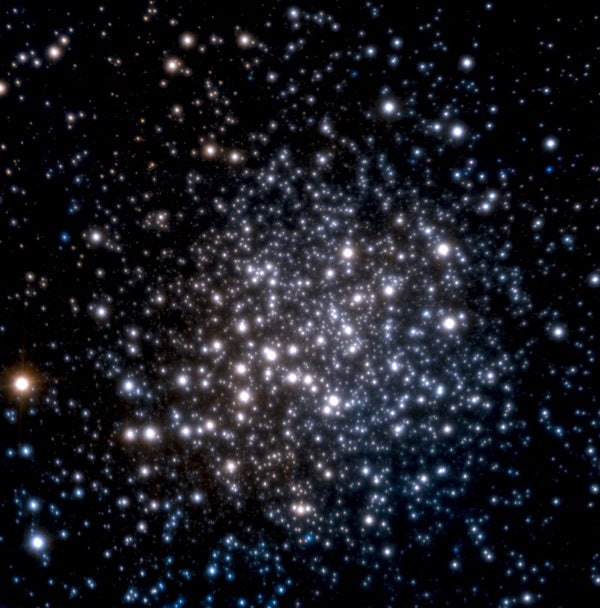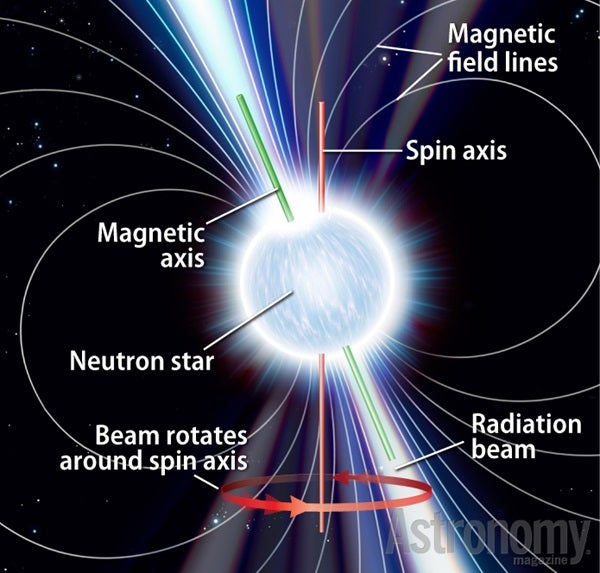What is PSR J1748–2446’s claim to weirdness fame? Simple. It’s the universe’s fastest-spinning celestial object. It’s also a star whose surface is not just solid, but harder than a diamond. Its density is 50 trillion times greater than lead. Its magnetic field sizzles a trillion times more intensely than our Sun’s. In a nutshell, it’s the most extreme example of a neutron star.
A neutron star forms when the core of a heavy sun, with the mass of about a few million Earths, collapses into a tiny sphere while the rest of its body hurtles outward during a supernova explosion. When this occurs, the inverse-square law of gravity goes into its demo-mode with a vengeance. Because this star no longer has a fusion generator, and thus no outward-pushing pressure to keep it from collapsing, gravity has a free hand. When the collapsing star gets five times smaller, its inward-pulling surface gravity becomes 25 times fiercer. When the star shrinks to 100 times smaller than it was before, its surface gravity now sucks inward with 100 x 100 (i.e., 10,000) times more force — and it keeps going. The smaller the star becomes, the more violent its collapse.

Bringing the universe to your door. We’re excited to announce Astronomy magazine’s new Space and Beyond subscription box – a quarterly adventure, curated with an astronomy-themed collection in every box. Learn More >>.
Normal 1-solar-mass stars stop collapsing when they’re the size of Earth. Then, electron degeneracy pressure halts the show because each electron needs a bit of breathing room. But if a star’s mass is more than 1.4 Suns — the famous Chandrasekhar limit — as PSR J1748–2446 originally was, then electrons get squeezed into the protons and the collapse continues. At this point, the previously separate atomic particles lose their identities. Everything becomes a neutral ocean of ultra-dense goo, and a few million Earths now pack into a ball less than 20 miles (30 kilometers) wide — a star that could barely cover Los Angeles.
Its spin ratchets up, too, like an over-caffeinated ballerina. Such collapsed stars often rotate 20, 30, or even 100 times a second. But if a neutron sun has a companion star as this one does, then newly captured material can speed it up further still. PSR J1748–2446 spins 716 times every second!
It’s hard to visualize. In everyday life, the fastest-spinning thing we might see is the blade on a kitchen blender or a circular saw. But those never rotate more than a few hundred times a second. This star’s equator moves at one-quarter the speed of light. This rotation of 43,000 miles (70,000km) per second would be like Earth’s equator completing nearly two spins a second instead of one a day.
Imagine living there. Taxes would be very low, but there’d also be several significant drawbacks. The gravity would crush you down so that your protoplasm would spread itself evenly around the surface like a film of oil. You couldn’t stand more than one atom high. But if you could still somehow remain conscious, you’d see every star in the sky cross the heavens from horizon to horizon in less than a thousandth of a second, each appearing as a solid line. Studying the cosmos might be a challenge.
Indeed, PSR J1748–2446 rotates about as rapidly as possible. If it went any faster, it would fling its material into space like whipped cream tossed into a fan.
The only visible object that could theoretically surpass the density of this crushed “superball” is a “quark star.” In 2002, researchers announced finding exactly such an object, but it was soon rejected by nearly the entire astrophysical community, which faulted the evidence. So the record stands today.
This fastest-ever pulsar is parked in a globular cluster of stars in Sagittarius the Archer, 18,000 light-years away, in the direction of our galaxy’s center. Called Terzan 5, the cluster is hard to see because foreground dusty gas heavily obscures it. In fact, Terzan 5 is itself quite unusual, having a higher star concentration than any other cluster and also housing stars born in different periods. Some think this cluster is actually the remnant of a dwarf galaxy cannibalized by our Milky Way.
PSR J1748–2446 is also weird because it is part of a binary star system. Its companion is a swollen giant that nonetheless contains just one-seventh our Sun’s mass; this pair whirls around each other in a perfectly circular orbit every 26 hours. Doing so, the companion passes in front of the pulsar daily, blocking 40 percent of its light. This adds a precise clockwork dimming to its ultra-fast flashes, making it simultaneously variable in two different ways.
The whole thing just gets curioser and curioser.












